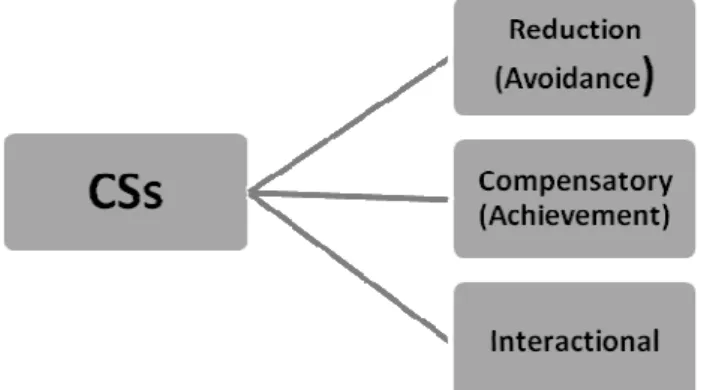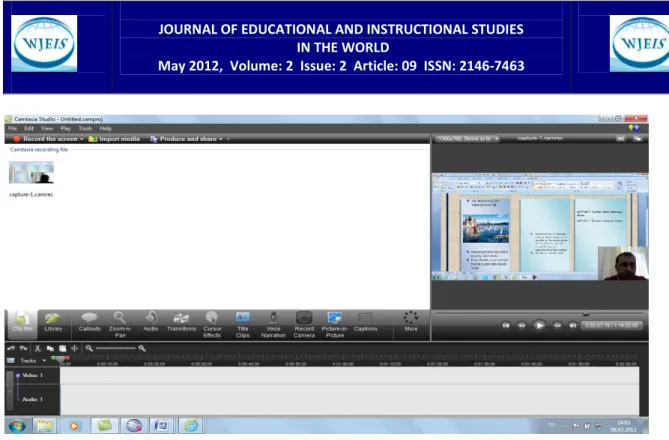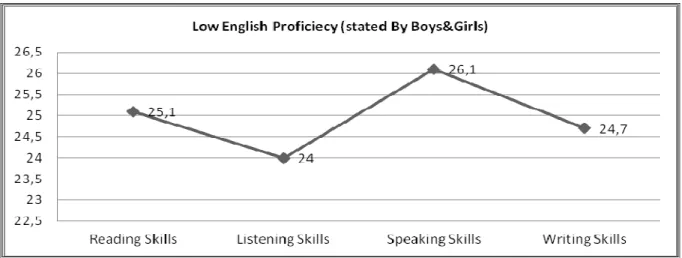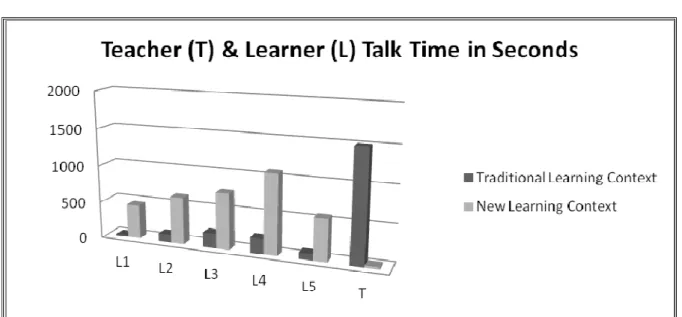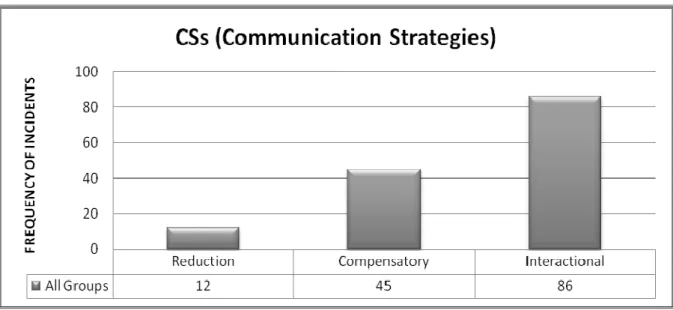COPYRIGHT @JOURNAL OF EDUCATIONAL AND INSTRUCTIONAL STUDIES IN THE WORLD 69
CLASSROOM INTERACTION VIA SYNCHRONOUS TECHNOLOGY ENHANCED TASKS
Res. Assist. Zeynep Yaprak Dicle University The Faculty of Education Department of Foreign Language
Diyarbakir, TURKEY
Abstract
The issue of adopting of cutting-edge technologies in ELT classroom has expanded rapidly over the last few years. However, increasing oral proficiency still remains as a serious shortcoming in the field of applied linguistics. This study attempts to demonstrate the exploitation of synchronous technologies such as Web messengers (Skype, Messenger, Gtalk etc.) to design interactive tasks can promote language socialization, collaboration, and more meaningful communication in positive affective language learning environments. Put an emphasis on learning to interact through completing a computer assisted task, namely, achieving a shared goal, has not only improved the speaking skills by providing natural interdependence between the learners but also maximized individual accountability with learner-centered approach. In the first part of the present study, participants were asked to complete a questionnaire in order to find out their self-assessment of target language proficiency. Then, randomly chosen sample pairs were assigned to work on a computer assisted task through interacting via messenger. Lastly, for data analysis, transcription, and screen shots Camtasia Studio, screen video capture software, and Atlas.ti were used.
Key Words: Synchronous & Asynchronous Interaction, Collaboration, TBLL (Task-based Language Learning),
CALL (Computer Assisted Language Learning).
LITERATURE REVIEW
Language Collaboration& Socialization
‘A more practiced eye, A more receptive ear, A more fluent tongue, A more involved heart, A more responsive mind’ (Oxford, 1990: ix) From the collaborative-social perspective, language learning context needs to support linguistic and social interdependence with various tasks between learners in order to maintain active language use. In this sense, while learners collaborate to perform their tasks through sharing resources, they also take part in the functions of language socialization like ‘thinking, feeling, and acting’, and thereby they ‘internalize and gain competence’. Specifically, in a collaborative atmosphere, language use serves both as an aim and medium of socialization; that is to say, learners are socialized by means of language use and also socialize to use language (Ochs, 1986: 2-3). In parallel with this respect, Norton (2000: 132) disfavors language learning’s being defined, in an unsophisticated manner, as ‘simply a skill’ rather than ‘a complex social practice’ which turns blind eye to the ‘identities’ of its learners. In terms of framing a theoretical model that forms the basis for socialization in language learning, context primarily needs to provide interaction between linguistic and values of that society. Therefore, while being exposed to the structural or lexical input, learners also need to bring the realities of their life styles or immediate environment to the context. This not only gives way to the transmission of linguistic knowledge; but also adds some flexibility to the learning process from the points of need analysis, material development, and language activities.
COPYRIGHT @JOURNAL OF EDUCATIONAL AND INSTRUCTIONAL STUDIES IN THE WORLD 70 Considering language education from the point of classroom interaction, Tsui (2001: 121) defines the interactional chain as ‘modified input’ or in accordance with Krashen (1985) theory as ‘comprehensible input’, ‘output’, and ‘interaction’. In this interaction model, input refers to the linguistic data fed into the communication process with modification devices like ‘repetition, exaggerated intonation, use of simple and short sentences’ which maximizes the comprehension degree of message transmission. On the other hand, output corresponds to the ‘language produced in reply to input’. Based on interactional hypotheses, Stephen Krashen (1985) indicates that acquisition of the target language can be achieved by being exposed to comprehensible input. Simply put, interaction initiated with simple syntax and focus on key words may facilitate the acquisition process. In this aspect, as teachers generally take up the initiator role in classroom interaction, they take the most responsibility. During this ‘interactional architecture of language classrooms’ (Seedhouse 2004), teachers usually initiate the interaction with knowledge- check questions; and in turn, they try to get answers from the learners. In accordance with the given answers, they provide their feedbacks. Because of its evaluative mode, this interaction cycle hinders learner linguistic participation; namely, output. On the other hand, scholars (e.g., Swain 1995) who advocate the Output Hypothesis considering foreigner talk (interaction between native and non-native speaker) stress that language output built by learners’ active participatin in dealing with communication breakdowns can be more conducive to language acquisition. During the interaction with high degree of communicativeness to overcome these breakdowns, interlocutors take action such as modifying structure, using different words, and repeating the message. As they are aimed at achieving the comprehensibility of the message, these moves are defined as ‘negotiation of meaning’ (Pica, 1994). In this process, while speakers are trying to reach an agreement through ‘modifying and restructuring the interaction’ (Pica, Young and Doughty 1987; Allwright 2000), they automatically scaffold their linguistic output and have longer participation. With respect to the effect of negation of meaning on input and output, Krashen (1982: 60) stated that “The more you talk, the more people will talk to you. Actual speaking on the part of the language acquirer will thus affect the quantity of the input people direct at you”. In authentic communication, achieving a clear understanding between the speakers can promote longer conversion or generate new topic in accordance with the produced outputs.
Computer Mediated Interaction through Task- Based Approach
Exploiting networked computers in language teaching plays an important role in gaining learners new perspective about having interaction on digital platform. Regarding occurring in real time or in accordance with learners’ own agenda, interaction can be divided into two main types as ‘synchronous’ or ‘asynchronous’ respectively. With the synchronous mode learners can experience ‘technostress’ due to the necessity of providing an ‘immediate response’. However, on the other point, they do not deal with time and place limits factors. While synchronous form of interaction share some similarities with the face-to-face mode in terms of providing input, giving feedback, and producing output, still it is more encouraging in relation to promoting negation of meaning and thereby, the use of communicative strategies due to its role of providing speakers with privacy in collaboration. That is to say, with more personal space while using their own computers, interlocutors are less affected with the negative aspects of language ego; namely, identity.
In order to exploit this live connection between the speakers at utmost level from interaction perspective, learning context or tasks need to be designed accordingly to promote ‘performance that [learners] typically cannot execute alone (Lee, 2002). Language task which engages all parties with high degree of communicativeness and promises technological appropriateness should pass the quality evaluation. As a subpart of quality evaluation, to base the content (Bradin, 1999) on SLA theories; in other words, gain it a linguistic value has a great significance.
Communication Strategies (CSs)
The main goal of foreign language teaching is to develop learners’ communicative competence through giving prominence not only to the meaning and also to the form. In this respect, the scrutiny of classroom interaction and the mechanisms that learners employ in order to solve communication problems have become to an important aspect in language classrooms and researches. From this perspective, Tarone (1977:195) defines communication strategies as a ‘mutual attempt’ done by the speakers to handle with ‘the crisis which occurs when language structures are inadequate to convey’ the message. Emerged in 70s as a new notion in applied linguistic field, communicative strategies have played a crucial in terms of bringing a new viewpoint; learner
COPYRIGHT @JOURNAL OF EDUCATIONAL AND INSTRUCTIONAL STUDIES IN THE WORLD 71 perspective to the classroom interaction. CSs studies revealed two underlying defining criteria; namely,
problem-orientedness and consciousness (Dornyei& Scott 1977). That is to say, CSs are seen as the language devices employed by the interlocutors in order to solve communication problems. As a second criterion
consciousness including the senses intentionality, attention, awareness, and control (Schmidt 1994), strategies are used by the learners consciously while reaching the communicative goal. For the conceptualization and comprehensive classification CSs can be categorized under three main types as reduction (avoidance), compensatory (achievement), and interactional.
Figure 1: Taxonomy of Communication Strategies Based on Dornyei & Scott 1995a, 1995b, Færch and Kasper 1983; Tarone 1977
Reduction (Avoidance) Strategies: Adapting the message through changing, reducing, or abandoning the topic.
• Message Abandonment
• Message Reduction
• Message Replacement
Compensatory (Achievement): Changing the concept to be expressed with the use of available linguistic store.
• Circumlocution: Giving example or describing the object or action.
• Approximation: Using a single alternative lexical item.
• Word-coinage: Creating a non-existing L2 word by applying a supposed L2 rule to an existing L2 word.
• Literal translation: Translating literally a lexical item from L1/L3 to L2.
• Code switching: Including L1/L3 words with L1/L3 pronunciation in L2 speech.
Interactional Strategies: Attaining a ‘communicative goal’ through negotiating the meaning (Tarone 1980:420).
• Other-repetition: Repeating something the interlocutor said to gain time.
• Direct appeal for help: Turning to the interlocutor for assistance by asking an explicit question concerning
a gap in one’s L2 knowledge
• Asking for repetition: Requesting repetition when not hearing or understanding something properly.
• Asking for clarification: Requesting explanation of an unfamiliar meaning structure
• Asking for confirmation: Requesting confirmation that one heard or understood something correctly.
METHODOLOGY Participants and Setting
The participants are student teachers majoring in English Language Teaching at Dicle University, in Diyarbakır. The students are all Turkish and aged between 18 and 21. In order to have a starting point for this study and have a good understanding related to the participants’ profile, 65 students(Boys+ Girls) were asked to complete a survey questionnaire included sections; namely, background knowledge (age& gender) and prior language experiences. For the application stage; task completion, 8 participants were randomly chosen and divided into 4 groups as a pair. Participants were mostly noted to have teacher-directed language education background, which puts the emphasis on the teacher initiated and dominated interaction as well the study of language itself rather than student-student interaction and interactive use of language. Therefore, for the elimination of the negative effects that could be caused by the novelty of CMI and online task, participants were fully informed about the computer applications, the process, and task goals.
COPYRIGHT @JOURNAL OF EDUCATIONAL AND INSTRUCTIONAL STUDIES IN THE WORLD 72
PROCEDURE & METHODS
This study has been shaped around the grounded theory (GT) which gained a new perspective to the research in social sciences (Glaser& Holton 2004). In contrast with the traditional research which firstly determines research questions or hypothesis and analysis the collected data in accordance with these questions, this method is based on ‘logico-deductive theory’ (Glaser & Strauss, 1967); expressively, it generates its theory from the data. For this research also, rather than beginning with research questions, first of all tasks were designed in accordance with the criteria of quality evaluation in order to achieve high degree of appropriateness and communicativeness through task-based online learning. As a next step, data was collected through conducting survey questionnaire and an online interactive task. From these collected quantitative and qualitative data, some key points were searched and categorized under similar codes. In line with these codes, hypothesis emerged and relative literature was reviewed to base the findings on theoretical framework. Taking grounded theory as a base, in the task, stage participants were divided into 4 groups of two with each student accessing one computer. Each pair was assigned to the role of being organizers of ‘Turkish Night’ in abroad. As a product, they were asked to prepare a three leaf brochure containing information and pictures about the night. The following template was designed to facilitate the process and to get the participants’ attention mostly to the interaction rather than technological procedures.
Figure 2:Brochure Template
In order to capture all screen movements in real time to visualize the process, Camtasia Studio which doesn’t cause any disruption while studying on the computer, was used.
COPYRIGHT @JOURNAL OF EDUCATIONAL AND INSTRUCTIONAL STUDIES IN THE WORLD 73 Figure 3:Camtasia Studio Screen Recorder
For the systematic classification and arrangement of the data rooted in the participants’ interaction, a number of matrixes, schemes, and taxonomies were exploited or adapted from the literature.
Data Analysis
A comprehensive construction for a detailed analysis of context and learning process, a number of quantitative and qualitative methods were used such as frequency, pattern, and conversational analyses. In order to map and induce the linguistic and affective aspects grounded in the collected data, the Grounded Theory (GT) was put into action. The analysis of the recordings and their conversational analysis let the critical moments to be coded around the emerged themes. In this respect, conversational analysis also allowed for the interpretation of the participants’ social performance through the analysis of linguistic component. During the generation of hypotheses from the interactional data, Atlas.ti , a computer software facilitating the systematic analysis of data through letting the user code the material including text, audio, and video.
COPYRIGHT @JOURNAL OF EDUCATIONAL AND INSTRUCTIONAL STUDIES IN THE WORLD 74 Coding the qualitative data let to categorize the learning outcomes into theme of communication strategies
employed by the participants during the online task completion. In accordance with the Grounded Theory (GT), after the analysis of the data, literature was reviewed to conduct a more detailed analysis around the emerged theme. At the end of this in depth scrutiny, communication strategies, were grouped under 13 strategies as (1)Message Abandonment; (2) Message Reduction; (3) Message Replacement; (4)Circumlocution; (5)Approximation; (6)Word-coinage; (7)Literal translation; (8)Code switching; (9)Other-repetition; (10)Direct appeal for help; (11)Asking for repetition; (12)Asking for clarification; (13)Asking for confirmation.
RESULTS&DISCUSSION
In terms of raising learners’ self-awareness of own language competence and empower them to take the responsibility of diagnosing their language gaps, and thereby improve themselves, participants were asked to reflect on target language proficiency. As shown in Table 1, among all four skills participants (boy& girls) mostly state that they have considerably low speaking which they need to improve in order to attain high English proficiency. Taking this result as a departing point, this study put the emphasis on the biggest problem of EFL classrooms; communication.
Table 1: Participants Self-Evaluation
Teacher & Learner Talk
As stated by Cazden (1986: 432), in terms of classroom interaction, communication can be seen as a ‘problematic medium’. As a social and linguistic entity, classroom needs to be addressed as a setting formed in cooperation with its members (Seedhouse 1996), and thereby, this problematic medium should be taken into consideration not only from teacher but also from learner perspective. In this respect, concerning the learner active participation and output, in traditional learning& teaching context, due to the some aspects below, language teachers mostly obstruct learning opportunities and minimize the learners’ language outputs (Walsh 2002):
• Teachers largely control the topic of discussion;
• Teachers often control both content and procedure;
• Teachers usually control who may participate and when;
• Role relationships between teachers and learners are unequal;
• Teachers talk most of the time;
COPYRIGHT @JOURNAL OF EDUCATIONAL AND INSTRUCTIONAL STUDIES IN THE WORLD 75 Table 2:The Quantity of Teacher& Learner Talk Time Recorded in Two Settings
Based on the recoded talk time of teacher and learners, selected randomly for this stage and the task stage it can be stated that in traditional setting learners’ linguistic contributions were mostly initiated by their teachers. On the other hand, in new learning setting they took that responsibility and they also took the role of
sustaining the continuity of interaction throughout the task. In the first setting, teacher talk time was noted as 1503 seconds of all recorded 2400 seconds of actual talking time, which corresponds to 62.6 % of
classroom interaction. In the new learning setting, it was only recorded as 45 seconds which is about 4.1% of all actual talking time of one pair work.
Table 3: Learner Output In Two Settings
Randomly Selected Learners
Traditional Learning Context (Talking Time in Seconds)
New Learning Context (Talking Time in Seconds)
L1 22 460
L2 105 637
L3 198 760
L4 207 1081
L5 90 569
To summarize the findings, in traditional setting learner language outputs were most often obstructed by excessive teacher talk through the mode of responding to teacher questions, in the new learning one, on the other hand, learners displayed longer and meaningful language output not only in the mode of responding to their peers’ questions but also in the mode of initiating questions and giving their opinions.
Communication Strategies Occurred During the Online Task-Based Activity
With the recognition of the gap between their linguistic outputs, participants were observed and recorded to use a number ofCSsin order to ‘make up for their L2 deficiencies’ (Dornyei& Scott 1997). These exploited CSs accepted as ‘potentially conscious plans’ (Færch&Kasper, 1983: 36) for handling language difficulties and in general communication breakdowns were classified (Dornyei& Scott 1995a; Færch&Kasper, 1983; Tarone, 1977; Váradi,1980) in accordance with the collected chat scripts.
COPYRIGHT @JOURNAL OF EDUCATIONAL AND INSTRUCTIONAL STUDIES IN THE WORLD 76 Table 4:Distribution of Strategies Used by the Participants
With respect to the participants’ use of communication-management devices, scripts put forward that learners mostly applied compensatory (achievement 31.4%) and interactional strategies (60.1%) rather than the reduction (avoidance 8.3%) ones. This shows that sharing the same goal; that is to achieve healthy interaction in order to complete the assigned task fostered linguistic action and also risks between the interlocutors. Instead of leaving the message unfinished or wasting time with the unrelated topics, learners took more active role and paid more effort to handle with the communication breakdowns and to sustain the continuity of the interaction.
Table 5:Reduction (Avoidance) Strategies
As an avoidance strategy, learners chose to reduce the points challenging due to the lack of some linguistic elements.
Excerpt 1 #Message Reduction: Students are discussing about the event schedule for the night and they are
trying to find out what they can put on the schedule right after the meal. S1 (Student 1) thinks that theatre show and dancing can be an alternative, on the other hand, S2 experiences some linguistic difficulties while
COPYRIGHT @JOURNAL OF EDUCATIONAL AND INSTRUCTIONAL STUDIES IN THE WORLD 77 explaining the point that theatre show following the meal may make people sleepy. Thus, S2 reduces the topic with the words available in her language store.
S1: Maybe…I think we can add theater… show.
S2: Theater show?... Dancing…dance?
S1: Maybe the other hour dance is suitable.
S2: After the meal people sleep…they see…and watch theatre …dancing…
S1: OK...dancing…
S2: Type of dances?
Table 6:Use of Compensatory (Achievement) Strategies
In relation to compensatory strategies, the results suggest that learners use a wide range of strategies in order to handle with the communication problems and adjust the communication accordingly. Through exemplifying the object or action (circumlocution), using alternative lexical items to convey the intended message (approximation), and manipulating their linguistic knowledge either by morphological creativity or transfer (word-coinage, literal translation, and code-switching), participants tried to overcome the limitations in their language production.
Excerpt 3 # Circumlocution (Paraphrase): S1 wants to determine the name of the people that they are going to
write on the brochure as organizers. However, because of S2’ s linguistic limitations related to the word of ‘organizer’, S1 paraphrases the word through giving its definition.
S1: What do you think about the name of the organizers?
S2: Just write the organizations not the name of…I think.
S1: We must choose the name of the people who organize…organisate… this organization.
S2: Hmm …I’m
Excerpt 4 # Approximation: For the name of the night, S1 suggests ‘From Flight Turkish Delight’ and uses
alternative lexical item ‘air’ for the ‘flight’ as a response to the S2’s seeking for confirmation for what he has heard.
S1: OK…err...xxx we write …welcome to from flight Turkish delight
S2: I think you should write in middle…err...one…just type Turkish delight. What did you say? Flight?
S1: …flight…air…
COPYRIGHT @JOURNAL OF EDUCATIONAL AND INSTRUCTIONAL STUDIES IN THE WORLD 78 Table 7:Use of Interactional Strategies
With the intention of achieving mutual understanding with their partners, learners made use of a number of ‘interactional meaning-negotiation mechanisms’ (Dörnyei &Scott 1997) which correspond to 60.1% of all used strategies. In this interactional process, in order to reach their communicative goal and address the gap in target language, learners asked their partner’s assistance. Additionally, they requested repetition, explanation, and confirmation to improve their interaction. To sum up, learning process enhanced with synchronous CMI maximizes participation and increase both the quantity and quality of the learners’ language output.
Excerpt 5 #: Direct Appeal for Help: Students are discussing about what they are going to write as a welcome
note.S2 asks S1’s assistance for the English equivalence of the word ‘sabırsızlıkla beklemek’ [Looking forward to].
S1: We will be glad to see you in traditional clothes.
S2: And.
S1: Do you think we should write another sentences?
S2: sabırsızlıkla beklemek? [Looking forward to?]
S1: Sabırsızlıkla beklemek? [Looking forward to?]
S2: Looking forward…waiting patiently…looking forward…look forward, yes.
S1: Forward to see you?
Excerpt 6 #: Asking for Confirmation: Students are negotiating about the name of the night and at this point S2
requested confirmation that she heard her partner correctly. S1: I select and design the picture.
S2: You are designing. We must find name for the night.
S1: Yes..you are ..right..Name..xxx or Turkish club. I think shortly…
S2: Name of …the night..You mean we should find shorter than this? S1: Yes, shorter than this.
CONCLUSION & IMPLICATIONS
Concerning the learners’ active involvement and meaningful linguistic performance, teachers of EFL are highly criticized due to their excessive and constructive talk time. According to Walsh (2002); most of the time
COPYRIGHT @JOURNAL OF EDUCATIONAL AND INSTRUCTIONAL STUDIES IN THE WORLD 79 teachers disallow the learners’ opportunities of language use through ‘filling the gaps’ with their dominant role and control of language. In this respect, they not only control the content, organizations of the activities but also determine learners who will take the turns. The role share becomes unequal, and as a result, learners’ involvement, which contributes to language acquisition, is minimized. While this is happening in traditional classrooms, on the other hand, in new learning context blended with new trends and informational technologies, it can be seen that in CMI environment learners through working on a more challenging task, learners have the opportunities of equal participation, longer and meaningful language use and learner output Additionally, as revealed in data in this setting it is also viewed that learners use a wide range of communication strategies in order to navigate their task and therefore to reach their communicative goal. In terms of ‘achieving mutual understanding’ (Dornyei & Scott 1997), between the communication strategies which can be grouped under the three main types as (1) Reduction (Avoidance), (2) Compensatory (Achievement), and lastly (3) Interactional, learners are noted to use mostly the second and third types. This shows that rather than leaving the message unfinished, completely abandoned or filling the turns with unrelated points, learners try to make good use of their turns through the strategies of exemplifying, describing, using their linguistic creation, or searching for an alternative lexical item which shares the same semantic aspects. Furthermore, in order to check the process and to maintain the continuity of the interaction, they appeal for their peers’ help, ask for repetition, confirmations, or request clarification for the unclear points. Put differently, CMI enhanced with meaningful tasks not only maximize the quantity and quality of learner output but also allow and foster the use of communication strategies which mostly cannot be seen or are unfortunately denied in traditional learning environments. In this sense, in order to have a healthy application of the new trends in language teaching, pre- & in-service teacher education programs primarily should give the prominence to the teachers’ roles, their use of language , and the learning opportunities that they provide in their classrooms through the use of new teaching & learning approaches, and the exploitation of informational technologies.
Acknowledgements: I would like to express my gratitude to TechSmith Corporation, (Camtasia Studio) and Atlas.ti.
WJEIS’s Note: This article was presented at International Conference on New Trends in Education and Their Implications - ICONTE, 26-28 April, 2012, Antalya-Turkey and was selected for publication for Volume 2 Number 2 of WJEIS 2012 by WJEIS Scientific Committee.
REFERENCES
Allwright, D. (2000). Interaction and negotiation in the language classroom: their role in learner development. Available as CRILE Working Paper 50.
Bradin, C. (1999). CALL issues: instructional aspects of software evaluation. In J Egbert et al (eds.), CALL Environments: Research, Practice, and Critical Issues. Alexandria: TESOL, pp.159-175.
Chapelle, C. A. (2001). Computer Applications in Second Language Acquisition. Cambridge: Cambridge University Press.
Dörnyei, Z., & Scott, M. L. (1995a, March). Communication strategies: What are they and what are they not?
Paper presented at the Annual Conference of the American Association for Applied Linguistics (AAAL), Long Beach,CA.
Dörnyei, Z., & Scott, M. L. (1995b). Communication strategies: An empirical analysis with retrospection. In, J. S. Turley&K. Lusby (Eds.), Selected papersfrom the proceedings of the 21st Annual Symposium of the Deseret Language and Linguistics Society (pp.155-168). Provo, UT: Brigham Young University.
Dörnyei, Z., & Scott, M. L. (1997). Communication strategies in second language: Definitions and taxonomies.
COPYRIGHT @JOURNAL OF EDUCATIONAL AND INSTRUCTIONAL STUDIES IN THE WORLD 80 Færch, C.,&Kasper,G. (1983). Strategies in interlanguage communication. Harlow, UK: Longman.
Glaser, Barney G & Strauss, Anselm L., (1967). The Discovery of Grounded Theory: Strategies for Qualitative Research, Chicago, Aldine Publishing Company.
Glaser, B. G., & Holton, J. (2004). Remodeling grounded theory: Article 4. Forum: Qualitative Social Research, 5(2), 1-17.
Hubbard, P. L. (pre-publication copy). In L. Dulcate and N. Arnold (eds.) 2006. Calling on CALL:From Theory and Research to New Directions in Foreign Language Teaching. San Marcos: CALICO.
Krashen, S. D. (1982). Principles and Practice in Second Language Acquisition. Oxford: Pergamon. Krashen, S.D. (1985). The Input Hypothesis: Issues and Implications. New York: Longman Inc.
Lee, L. (2002). Synchronous online exchanges: A study of modification devices on non-native discourse. System, 30(3), 275-288.
Norton, B. (2000). Identity and language learning. Harlow, UK: Pearson.
Ochs, E. (1986). Introduction. In B. B. Schieffelin & E. Ochs (Eds.), Language socialization across cultures (pp. 1-13). New York: Cambridge University Press.
Oxford, R. (1990). Language Learning Strategies: What Every Teacher Should Know. Heinle & Heinle.
Pica, T., Young, R. and Doughty, C. (1987). The impact of interaction on comprehension. TESOL Quarterly 21: 737–58.
Pica, T. (1994). Research on negotiation: what does it reveal about second language learning conditions, processes, outcomes? Language Learning 44(3): 493–527.
Schmidt, R. (1994). Deconstructing consciousness in search of useful definitions for applied linguistics. In J. H. Hulstijn & R. Schmidt (Eds.), Consciousnessin second language learning [Special issue], AILA Review, 11, 11–26. Seedhouse, P. (2004). ‘The interactional architecture of the language classroom: A conversation analysis perspective,’ Language Learning 1: 1–300.
Swain, M. (1995). Three functions of output in second language learning. In G. Cook & B. Seidlhofer (Eds.)
Principle and practice in applied linguistics: Studies in honour of H. G. Widdowson (pp. 125-144). Oxford, England: Oxford University Press.
Tarone, E. (1977). Conscious communication strategies in interlanguage: A progress report. In H. D. Brown, C. A. Yorio&R. C. Crymes (Eds.), On TESOL‘77 (pp. 194–203). Washington: TESOL.
Tarone, E. (1980). Communication strategies, foreigner talk and repair in interlanguage. Language Learning, 30, 417–431.
Tsui, A.B.M. (2001). Classroom interaction. In R. Carter & D. Nunan (Eds.).The Cambridge guide to teaching English to speakers of other languages. Cambridge:Cambridge University Press.
Váradi, T. (1980). Strategies of target language learner communication: Message adjustment. IRAL, 18, 59–71. Walsh, S. (2002) 'Construction or Obstruction’: Teacher Talk and Learner Involvement in the EFL Classroom'.
